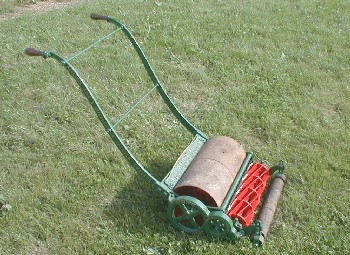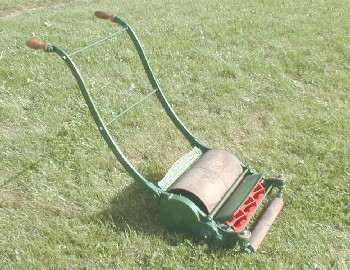MP035: Ransomes Bowling Green Mower

When the first lawn mowers were introduced in the 1830s they helped to revolutionise the way people managed the lawn.
Within a few years a number of manufacturers were promoting their mowers for their ability to help prepare sports surfaces although it was some time before special machines for the task were introduced.
The Ransomes Bowling Green mower was introduced specifically for use on bowling greens and other high quality sporting surfaces.
The mower is designed to ensure an extremely fine finish by producing a high number of cuts per inch of forward travel. This helps to reduce the "ribbing" often seen with conventional mowers on fine turf surfaces. Ribbing occurs when a mower misses a row of grass leaves as it moves across the lawn because the cutting cylinder is not making a cut as it passes over. Increasing the number of cuts made for any given length of forward motion reduces the potential for ribbing and increases the quality of cut. For domestic machines this is not normally a consideration but it is important on surfaces used for sports such as bowls, golf and croquet where an uneven surface can spoil the game.
Many people wrongly assume that the quality of cut is determined only by the number of blades on the cutting cylinder. However, in reality, the number of cuts per inch (the traditional way of measuring quality of cut) is governed by a combination of the number of blades on the cylinder and the number of times it rotates for a given amount of forward motion. This is dictated by the size of the rear roller and the gearing between it and the cutting cylinder. Therefore a cutting cylinder with four blades rotating quickly will give more cuts per inch than a six bladed cylinder rotating slowly.
The Ransomes Bowling Green Mower had a number of design features that helped improve the quality of cut:
- a large diameter rear roller (compared with conventional mowers of a similar width)
- self aligning and dust proof ball bearings helped ensure a true cutting action
- high speed cutting cylinder with ten knives or blades. These had a hard steel face to give a clean cut and were backed with wrought iron for added strength
- cylinder adjusted to bottom blade by a single screw at each end for greater accuracy
- extra thin bottom blade allowed the mower to cut extremely close to the lawn surface
- special fine screw adjustment allowed the user to set the cutting height very accurately
The Ransomes Bowling Green mowers were generally available in 15" and 18" cutting widths during the 1920s and 1930s.

